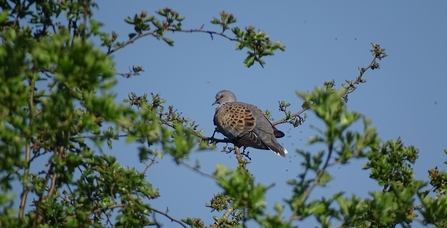My ears were tuned into the sounds of the common like radar dishes. It was a golden May day, blossoming with spring's verdant touch. Willow warblers whistled a sweet cascading melody, and the rocking andante of chiffchaffs echoed through the bushes and trees. Among the chorus was a third birdsong: a soft, rolling purr. This was the bird I came here to find, I was on a quest to find a turtle dove.
The purr became louder, more definitive, as I crept through the light hawthorn scrub and wildflowers. Just as I approached a large puddle, the song halted. I was stopped in my tracks as the tiny pigeon circled once over my head, wings held low and white-tipped tail fanned wide. After a seconds-long view of this rare gem, it dropped silently back behind a willow deep into the shrubbery. What a bird! But I was yearning for a better view, so I trundled through the puddle and was rewarded for my efforts. There I saw a beautifully demarcated male dove in the white-flowered hawthorn, its wings were laced with cracks of orange. This is such an amazing species that has faced an incredible and dangerous journey to arrive here.
The turtle dove is red-listed under the classification of endangered species, with just over 2,000 breeding pairs in the UK. Over the past 50 years they have undergone a shocking retraction in range, due to issues in all stages of their migratory cycle. The key threat to the doves here is habitat destruction: the species requires a diet based on seeds from a multitude of meadow plants, such as chickweed and fumitory. A couple hundred years ago, our English countryside teemed with large biodiverse hay meadows and thick hawthorn hedgerow. This is the perfect habitat for turtle doves but modern segregation of farmland into endless blocks of wheat and barley means that turtle doves are now unable to find the seeds of the specific plants they require. This intensive agriculture has occurred on such a large scale that there is nowhere left to go. The birds now only occur on very few nature reserves in Norfolk and soon there may be none left at all. But a good place to see them now is NWT New Buckenham Common, where at least 2 males have been singing this year!


